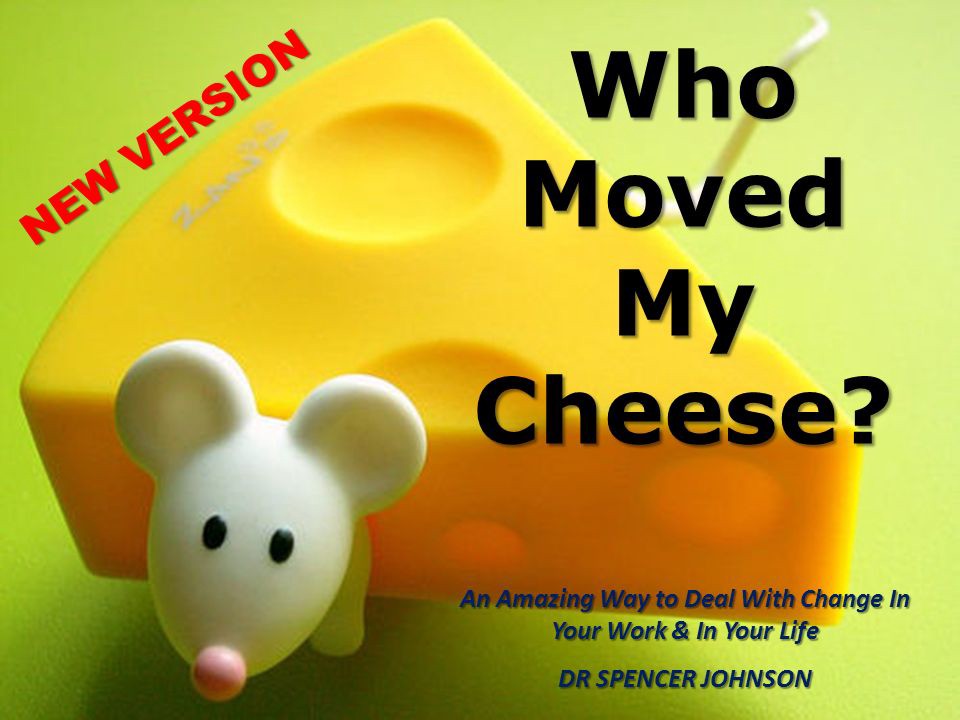Overview
A group of old school friends meet to catch up. They end up discussing the unexpected, unforeseen changes to their lives and one friend offers to tell a story about adapting to change. The story he tells involves four characters, two mice named Sniff and Scurry, and two “Littlepeople” named Hem and Haw. All of them are in a maze, looking for cheese, which they need to survive. For the “Littlepeople,” cheese also has a larger, metaphysical connotation in the sense that it also makes them happy—their Cheese is thus spelled with a capital C.
All of the characters find a Cheese Station and have a plentiful supply of cheese for a period of time. After a while, however, the cheese starts to run out. One day, when it disappears, Sniff and Scurry understand that their situation has changed and they decide to go in search of new cheese. Hem and Haw, on the other hand, stick around the same spot, looking for cheese and hoping it will reappear. While they are arguing about what to do and ranting about the injustice of their situation, Sniff and Scurry succeed in finding another Cheese Station in the maze.
Despite his fears about venturing into the unknown, Haw eventually decides to leave Hem and go in search of new cheese, too. It’s a long journey, but he is exhilarated by the search for something new. Along the way, he reflects on his situation and what he has learned about adapting to change. Haw writes these maxims about change along the wall of the maze in the hope that they might encourage Hem. Eventually, Haw finds a new, plentiful Cheese Station. Although he wants to help Hem, he realizes that no one else can make Hem change.
After the story is finished, the friends discuss its relevance to their lives and how they can apply it in personal and professional situations in order to increase their happiness and well-being.
- Change is an inevitable and constant part of life.
- Anticipating change can help you better handle it when it occurs.
- Letting go of old ways and habits can help you adapt to change and embrace new opportunities.
- Visualizing success and happiness can help you focus on what you can gain rather than what you’ve lost.
- Fear is immobilizing and can stop you from embracing new opportunities.
- It can be exhilarating to break out of old ways and begin the search for something new.
- It’s important to stay in touch with areas outside your comfort zone so you know what’s happening around you and are ready for changes if and when they occur.
Key insight 1
Change is an inevitable and constant part of life.
As Haw reflects on the disappearance of the cheese, he recognizes that circumstances are always changing. The cheese didn’t just disappear; it was diminishing all along. He sums up this insight with the idea that “the cheese keeps moving.”
The ancient Greek philosopher Heraclitus (535 BCE – 475 BCE) famously observed that a person can never put their foot in the same river twice.[1] What he meant by this was that change is a constant feature of the natural world and of living things. A rushing river, in which water flows in a perpetual, moving stream, epitomizes this idea of life’s inevitable alterations and transformations. Likewise, the person who steps into the stream cannot be the same from moment to moment, but is constantly evolving, both physically and in more subtle spiritual and psychological ways.
In an existence characterized by impermanence, the only enduring constant people can expect is change itself. This philosophical understanding has obvious applications in everyday life. For instance, a couple’s marriage, though it carries the promise of permanence, is constantly evolving and shifting with the changes in each individual and in their ways of relating to each other. In the business world, too, nothing is stagnant. New products, leaders, ideas, consumer interests, and other factors make change an unavoidable feature of the workplace and marketplace.
Key insight 2
Anticipating change can help you better handle it when it occurs.
Before the cheese disappears completely, Sniff and Scurry notice that it is diminishing. They expect that it will soon be gone, which helps them prepare for the day when they have to move on in search of new cheese. Because Hem and Haw don’t anticipate this change, they are less equipped, emotionally and intellectually, to handle it.
Some changes are unexpected and difficult to really prepare for—a sudden death, for instance, or an unforeseen accident. Many of life’s other changes, however, are signaled along the way or even known ahead of time. Parents often struggle, for instance, when their children decide to leave home. It may feel like a sudden break, but parents who anticipate this alteration in their lives plan ahead in order to ease the transition. They take up new activities, or embrace volunteer opportunities. If they worked only part-time or were stay-at-home parents, they might go back to work. These changes require forethought and planning, but by anticipating change, they can ease the feeling of absence that can come with an empty home.
Key insight 3
Letting go of old ways and habits can help you adapt to change and embrace new opportunities.
Sniff and Scurry find new cheese a long time before Hem and Haw because they accept the change. By letting go of the old cheese, they are able to discover and enjoy their new cheese sooner.
This idea is best encapsulated in the common maxim that when one door closes another opens. The catch, however, is that if you are preoccupied with the door that has closed—with this loss and the frustration it brings—you might not notice the door that has opened. This is a common experience in the professional world. A market, for instance, may shift away from one product, hurting business and frustrating executives who had expected to profit from certain conditions. As the market shifts, however, there is an opportunity to capitalize on new consumer interests and preferences. The leader who is able to let go of old expectations and adapt quickly to new conditions is more likely to find success than those stuck in the past. For instance, environmental concerns and consumer frustration with gas-guzzling SUVs created a market for more fuel-efficient cars, such as hybrids. Automotive industry leaders who recognized this opportunity have been able to capitalize on the shift. Meanwhile, those who failed to understand the cultural and political change in consumer thinking and its relevance to the car industry missed out on the opportunity.
Key insight 4
Visualizing success and happiness can help you focus on what you can gain rather than what you’ve lost.
Haw periodically visualizes himself discovering and enjoying the new cheese. This mental motivation helps him continue on his search, despite disappointments, and it keeps him looking to the future rather than the past.
Visualization of success is a popular psychological and meditation method for helping people focus on achieving their goals. In sports, for instance, athletes might prepare for an upcoming competition not only through physical training and practice, but also through mental visualization techniques: imagining themselves performing successfully on the field or the court. This emphasis on the future and on a positive outcome helps counteract negative thoughts, like the memory of unsuccessful performances in the past or athletes’ fears that they won’t be able to achieve their goal. Olympians are known to use visualization and imagery techniques as part of their mental preparation. [2] The popularity of these techniques indicate how much success can depend on emotional and psychological conditions—positive thinking, belief in the future, and an optimistic focus on achievement rather than failure.
Hear all the key takeaways from this book in audio
To read all the insights from this book please visit Instaread
With Instaread you can Instantly unlock the knowledge contained in the world’s best books and enjoy access to bestselling book summaries in 15-minute audio or text.



